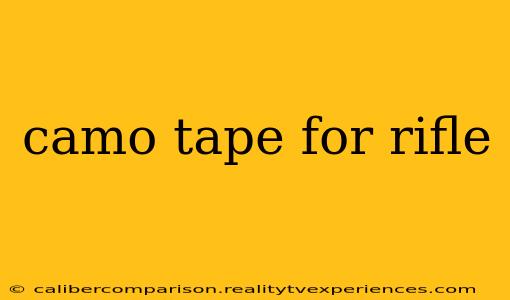Choosing the right camo tape for your rifle can significantly enhance your concealment in the field, protect your firearm from the elements, and even personalize its look. But with a plethora of options available, understanding the nuances of different types, applications, and benefits is crucial. This comprehensive guide dives deep into the world of rifle camo tape, equipping you with the knowledge to make informed decisions.
Types of Camo Tape for Rifles
The market offers various camo tapes, each with unique properties catering to specific needs and preferences:
1. Fabric Camo Tape:
- Material: Made from durable, rip-resistant fabric, often featuring a woven or knit construction.
- Advantages: Highly conformable, excellent for irregular surfaces, offers superior abrasion resistance, and provides a more textured camo pattern.
- Disadvantages: Can be slightly thicker than other types, potentially affecting weapon manipulation. May not adhere as strongly to smooth surfaces as other options.
2. Vinyl Camo Tape:
- Material: Thin, flexible vinyl with a strong adhesive backing.
- Advantages: Easy to apply and remove (leaving minimal residue), relatively waterproof, and available in a wide array of camouflage patterns. Excellent for smooth surfaces.
- Disadvantages: Less durable than fabric tape; prone to tearing under stress or abrasion. May not be suitable for extremely rough surfaces.
3. Rubberized Camo Tape:
- Material: A blend of rubber and other materials, offering enhanced grip and durability.
- Advantages: Excellent for harsh conditions, provides a non-slip surface, and resists abrasion better than vinyl tape.
- Disadvantages: Can be more difficult to apply and remove cleanly, may leave a more noticeable adhesive residue. Often more expensive than other options.
Choosing the Right Camo Tape: Key Considerations
Several factors influence your camo tape selection:
-
Environment: The type of terrain you'll be operating in dictates the appropriate camouflage pattern. Desert environments call for tan and brown patterns, while woodland settings might benefit from greens and browns. Consider using tapes specifically designed for your environment.
-
Weapon Type: The shape and surface texture of your rifle will influence tape choice. Fabric tape excels on rifles with irregular surfaces, while vinyl tape is better suited for smooth surfaces.
-
Durability Requirements: If your rifle endures harsh conditions, investing in a more durable fabric or rubberized tape is crucial. For occasional use, vinyl tape might suffice.
-
Ease of Application: Vinyl tapes generally offer easier application and removal, while fabric and rubberized tapes might require more patience and technique.
Applying Camo Tape Effectively
Proper application maximizes the effectiveness and longevity of your camo tape:
-
Clean the Surface: Ensure the rifle's surface is clean, dry, and free of debris. This guarantees optimal adhesion.
-
Plan Your Pattern: Before applying the tape, visualize the desired camo pattern and plan the placement of each piece to avoid gaps or overlaps.
-
Apply Slowly and Smoothly: Apply the tape gradually, smoothing out any air bubbles as you go. Work from the center outwards to prevent wrinkles.
-
Trim Excess Tape: Carefully trim any excess tape with a sharp blade, ensuring clean edges.
Beyond Concealment: Additional Benefits of Camo Tape
While concealment is the primary purpose, camo tape offers additional benefits:
- Protection: Acts as a protective layer against scratches, minor dings, and environmental elements.
- Improved Grip: Certain tapes enhance grip, particularly beneficial in wet or cold conditions.
- Personalization: Allows for customization and personalization of your firearm.
Conclusion: Mastering the Art of Camo Tape Application
Selecting and applying the correct camo tape for your rifle is an art form that combines practicality and aesthetics. By understanding the differences between tape types, carefully considering your environment and weapon type, and mastering the application techniques, you can significantly enhance your rifle's concealment, durability, and personal expression. Remember to always prioritize safety and handle your firearm responsibly.

